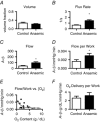Functional adaptations of the coronary microcirculation to anaemia in fetal sheep
- PMID: 27291778
- PMCID: PMC5088228
- DOI: 10.1113/JP272696
Functional adaptations of the coronary microcirculation to anaemia in fetal sheep
Abstract
Key points: In fetuses, chronic anaemia stimulates cardiac growth; simultaneously, blood flow to the heart muscle itself is increased, and reserve blood flow capacity of the coronary vascular bed is preserved. Here we examined functional adaptations of the capillaries and small blood vessels responsible for delivering oxygen to the anaemic fetal heart muscle using contrast-enhanced echocardiography. We demonstrate that coronary microvascular flux rate doubled in anaemic fetuses compared to control fetuses, both at rest and during maximal flow, suggesting reduced microvascular resistance consistent with capillary widening. Cardiac fractional microvascular blood volume was not greater in anaemic fetuses, suggesting that growth of new microvascular vessels does not contribute to the increased flow per volume of myocardium. These unusual changes in microvascular function during anaemia may indicate novel adaptive strategies in the fetal heart.
Abstract: Fetal anaemia causes cardiac adaptations that have immediate and life-long repercussions on heart function and health. It is known that resting and maximal coronary conductance both increase during chronic fetal anaemia, but the coronary microvascular changes responsible for the adaptive response are unknown. Until recently, technical limitations have prevented quantifying functional capillary-level adaptations in the in vivo fetal heart. Our objective was to characterise functional microvascular adaptations in chronically anaemic fetal sheep. Chronically instrumented fetuses were randomized to a control group (n = 11) or were made anaemic by isovolumetric haemorrhage (n = 12) for 1 week prior to myocardial contrast echocardiography at 85% of gestation. Anaemia augmented cardiac mass by 23% without changing body weight. In anaemic fetuses, microvascular blood flow per volume of myocardium was twice that of control fetuses at rest, during vasodilatory hyperaemia, and during hyperaemia plus increased aortic pressure. The elevated blood flow was attributable almost entirely to an increase in microvascular blood flux rate whereas microvascular blood volumes were not different between groups at baseline, during hyperaemia, or with hyperaemia plus increased aortic pressure. Increased coronary microvascular flux rate in response to chronic fetal anaemia is consistent with expected reductions in capillary resistance from capillary diameter widening detected in earlier histological studies.
Keywords: coronary circulation; fetal anemia; fetal heart; microvascular imaging.
© 2016 The Authors. The Journal of Physiology © 2016 The Physiological Society.
Figures



References
-
- Broberg CS, Giraud GD, Schultz JM, Thornburg KL, Hohimer AR & Davis LE (2003). Fetal anemia leads to augmented contractile response to hypoxic stress in adulthood. Am J Physiol Regul Integr Comp Physiol 285, R649–R655. - PubMed
-
- Carter BS, DiGiacomo JE, Balderston SM, Wiggins JW & Merenstein GB (1990). Disproportionate septal hypertrophy associated with erythroblastosis fetalis. Am J Dis Child 144, 1225–1228. - PubMed
-
- Davis LE & Hohimer AR (1991). Hemodynamics and organ blood flow in fetal sheep subjected to chronic anemia. Am J Physiol 261, R1542–R1548. - PubMed
-
- Davis LE, Hohimer AR & Morton MJ (1999). Myocardial blood flow and coronary reserve in chronically anemic fetal lambs. Am J Physiol 277, R306–R313. - PubMed
Publication types
MeSH terms
Grants and funding
LinkOut - more resources
Full Text Sources
Other Literature Sources
Medical

